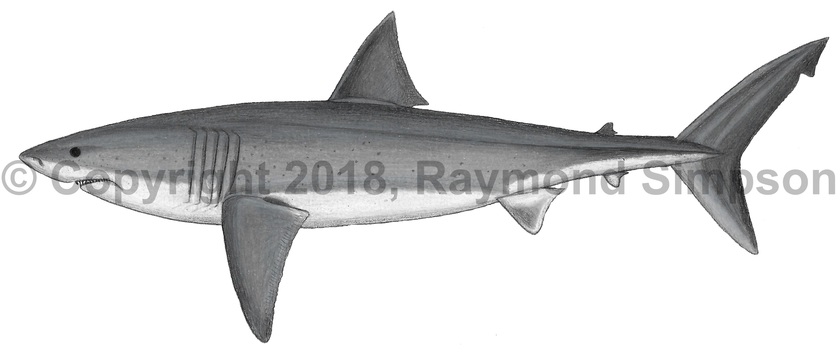
Common Name
Great White Shark
Year Described
Linnaeus, 1758
Identification
Upper jaw: 23-28 rows
Lower jaw: 21-25 rows
A large and robust shark. Snout relatively long and conical. Eye moderate. Nostrils midway between mouth and snout tip. Mouth almost as wide as head. Labial furrows small. Teeth large and triangular with serrated edges. Gill slits number five and are very long (3/4 of body depth). Posterior two slits compressed together before pectoral fin base. Body tapering posteriorly. Caudal peduncle much wider than tall with a low lateral keel and no secondary keel. First dorsal fin origin over free rear tip of pectoral fin. D1 concave on rear edge. Second dorsal fin tiny. Pectoral fin large and falcate with a concave rear margin. Pelvic fin larger than D2 and far behind level of D1. Anal fin about the size of D2 and originates behind level of D2. Caudal fin with precaudal pits above and below. Caudal fin lunate with a long lower lobe and well developed notch on upper lobe.
Color
Body ranges from dark gray to steel blue to brown, changing abruptly to white below with an irregular demarcation line. Generally unmarked otherwise. Sometimes has a black marking under pectoral fin. Fins body colored with slightly darker margins. Pectoral fins with black tips underneath. Eye jet black.
Size
Mature adults from 350-500cm TL. Maximum size possibly over 600cm TL. Juveniles at least 110cm TL. Females average larger than males.
Habitat
A very widespread shark found from tropical to temperate waters in both inshore and offshore habitats to over 1000m. Known to be highly migratory. An apex predator but mainly a predator of marine mammals as an adult.
Range
Canada to Argentina, including the Caribbean Sea, but most common in cooler waters.
References
Castro, J.I. 2011. The Sharks of North America. Oxford University Press, 640 pp.
Ebert, D. A., & M. Dando. 2020. Field Guide to Sharks, Rays & Chimaeras of Europe and the Mediterranean. Princeton University Press. 2020.